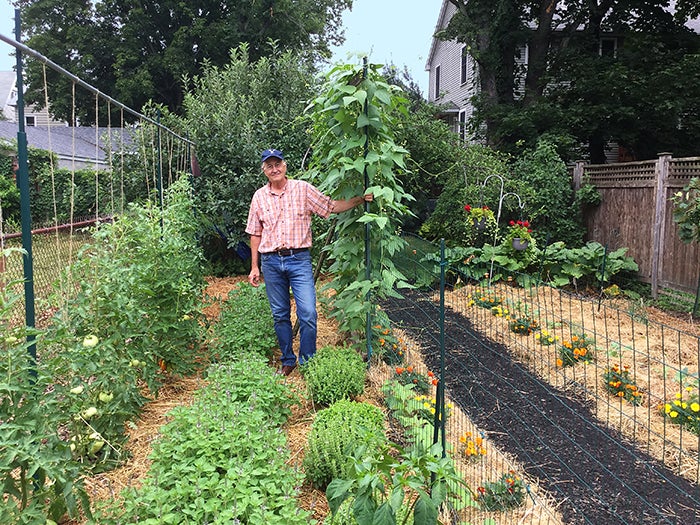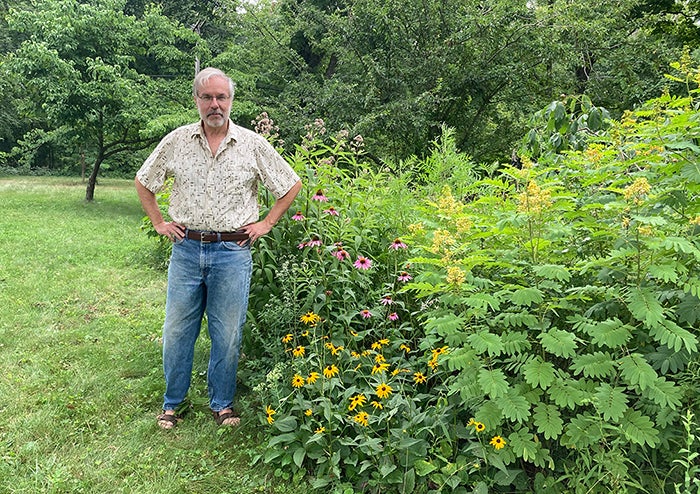We want to hear from you! Take the survey.
How do you use It’s Your Yale? How can it be improved? Answer for a chance to win Yale swag.
How do their gardens grow? Two staff members tell us.
In celebration of Staff Spirit Week and, in particular, Homes and Gardens Tuesday, we found two staff members who shared with us not only why they love gardening, but also how their relationships with their gardens have changed during the pandemic.
John Gambell
Director, Office of the University Printer
How would you describe your love of gardening?
Every year the garden is a dependable pleasure and a changing set of challenges. My father and grandfather were both serious vegetable and flower gardeners, and I suspect that my love of gardening springs from the fact that those men were at their happiest and most patient when I joined them in their gardens. When my father retired from his job in New York City, my parents moved to Kennebunkport where they ran a florist business.
Have you experienced a different relationship with your garden during the pandemic?
Now that I’m working from home, Martha and I get to spend more time in the garden. When I need a break from Zoom meetings, I can walk out the back door into our little green domain. Unlike much of what’s going on, I sense that we have some control over this 25-x-60-foot piece of our life.
What are some of your favorite plants (flowers and/or vegetables) and why?
Every year we grow Dr. Martin’s lima beans. It’s a heritage variety from south Jersey and nearby Pennsylvania. A great uncle gave me a handful of seeds about thirty years ago. If you don’t like lima beans, you’ll hate this variety. These aren’t baby limas. Flowers? I admire showy perennials that don’t demand much attention. Peonies and orange ditch lilies fill that bill.

Jim Sirch
Coordinator, Public Education at the Peabody Museum.
Author of the blog, Beyond Your Back Door.
How would you describe your love of gardening?
I love to grow plants from seed and get satisfaction from raising a tiny seedling to a mature plant. I also really think of my garden as providing ecosystem function. I plant for pollinators with local native plants, and I encourage people to do the same. In our country, lawns take up as much space as all of New England. A typical lawn is a biological desert and doesn’t provide food for pollinators. I like to teach homeowners about gradually getting rid of their lawns. Laying out wet cardboard on top of grass and covering with compost and mulch leaving it for a few months and then installing native plants that attract native bees, butterflies, moths, and hummingbirds.
Have you experienced a different relationship with your garden during the pandemic?
I have been able to get out during breaks. Instead of taking a walk at lunch, which I did regularly in New Haven, I go out to my garden. It’s been a great way to notice the changing seasons, new growth and how pollinators are interacting with what I’ve planted.
What are some of your favorite plants (flowers and/or vegetables) and why?
Where do I begin? A variety of plants native to the eastern US are not just functional but very attractive in the garden, such as Bee Balm (Monarda didyma), New England Aster (Symphyotrichum novae-angliae) and Swamp Milkweed (Asclepias incarnata). Broad-leaved Mountain Mint (Pycnanthemum muticum) is a pollinator powerhouse. I like to think about how I can help insect specialists, which are native bees, butterflies and moths who are tied to one specific type of plant. Certain native bees only get pollen from native willows such as Pussy Willow (Salvia discolor). Monarch butterfly caterpillars only eat milkweeds and without milkweeds they wouldn’t survive. I like asters and goldenrods, and they attract a huge variety of insects, including many specialists.



